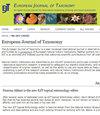Seven new narrowly endemic species of Gulella Pfeiffer, 1856 from eastern South Africa (Gastropoda, Streptaxidae) and status revision for another
IF 1.1
3区 生物学
Q3 ENTOMOLOGY
引用次数: 0
Abstract
Seven new species of very small Gulella Pfeiffer, 1856 are described from two regions in the interior of south-eastern South Africa within the Maputaland-Pondoland-Albany biodiversity hotspot. In addition, the status of Gulella darglensis benthodon van Bruggen, 1980 is revised and raised to species level. All species are very small-shelled and are narrow-range endemics. Six species, G. judithmastersae sp. nov., G. kevincolei sp. nov., G. hlathikhulu sp. nov., G. nkandla sp. nov., G. mystica sp. nov. and G. libertas sp. nov. are each known from only one locality. The first two as well as G. benthodon and G. mcmasteri sp. nov. are found only in the Amathole Mountains, where poaching, illegal harvesting of plant products and uncontrolled access of cattle take place, including in protected areas. The other four species each occur at one locality in north-central KwaZulu-Natal. The localities of three of the last-mentioned species are in protected areas although they are isolated and surrounded by a heavily transformed cultural landscape rendering enforcement of conservation legislation a challenge. Six species occur in nature reserves, highlighting the importance of small pockets of protected habitat for the conservation of terrestrial snails.南非东部七种窄特有种(腹足目,链足科)及另一种现状订正
在南非东南部马普塔兰-庞多兰-奥尔巴尼生物多样性热点地区,描述了7个非常小的Gulella Pfeiffer, 1856的新种。此外,本文还对Gulella darglensis benthodon van Bruggen, 1980的地位进行了修正,并将其提升到种的水平。所有种类都是非常小的壳,是窄范围的特有种。G. judithmastersae sp. nov.、G. kevincolei sp. nov.、G. hlathikhulu sp. nov.、G. nkandla sp. nov.、G. mystica sp. nov.和G. libertas sp. nov.这6个物种只在一个地方被发现。前两种,以及底栖巨齿兽和麦克马斯特巨齿兽只在阿马托尔山脉中发现,那里发生偷猎、非法收获植物产品和不受控制的牛群,包括在保护区内。其他四种分别出现在夸祖鲁-纳塔尔省中北部的一个地方。最后提到的三种物种的所在地都在保护区内,尽管它们是孤立的,并且被严重变化的文化景观所包围,这给保护立法的执行带来了挑战。六种蜗牛生活在自然保护区,这凸显了小块受保护栖息地对保护陆生蜗牛的重要性。
本文章由计算机程序翻译,如有差异,请以英文原文为准。
求助全文
约1分钟内获得全文
求助全文
来源期刊

European journal of taxonomy
ZOOLOGY-
CiteScore
2.30
自引率
8.30%
发文量
173
审稿时长
29 weeks
期刊介绍:
EJT is a fully refereed, international, fully electronic Open Access journal in descriptive taxonomy, covering subjects in zoology, entomology, botany (in its broadest sense), and palaeontology. EJT-papers must be original and adhere to high scientific (content) and technical (language, artwork, etc.) standards. Manuscripts that are clearly substandard in either of these categories will not be sent out for review. EJT is supported by a consortium of European Natural History Institutes, but its scope is global. Both authorship and geographical region of study need not be European. Authors are, however, strongly encouraged to involve European Natural History collections by consulting material or by depositing specimens (e.g. types and figured material) related to their published paper in the collection of a European Natural History Institute.
 求助内容:
求助内容: 应助结果提醒方式:
应助结果提醒方式:


